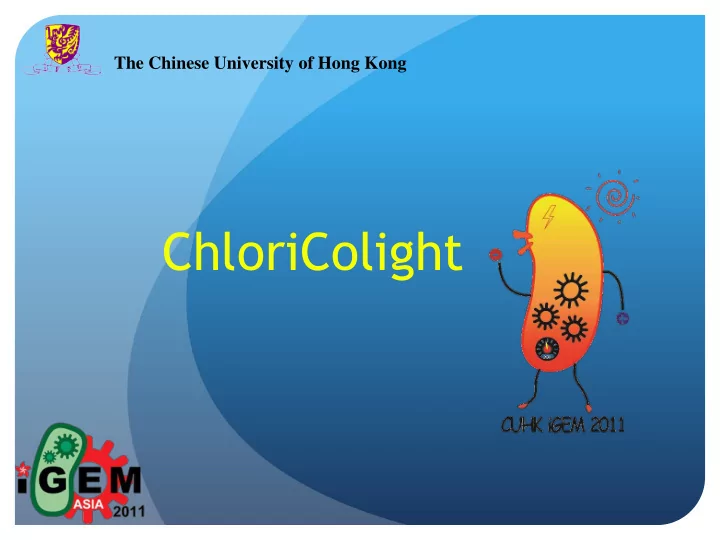

The Chinese University of Hong Kong ChloriColight
2 This Year, We… Photo-tunable ON/OFF system
3 Halorhodopsin (HR) Light-driven Chloride pump Halobacterium Facilitate chloride import (http://opm.phar.umich.edu/protein.php?pdbid=1e12)
4 Extracellular HR working principle Light OFF! Light ON! Halorhodopsin closed Halorhodopsin opened Chloride pumped in Closed Open Intracellular E.coli
5 Chloride Chlor E. li co light i
Biobricks construction Characterization Summary 6 Our Biobricks Constructed a Halorhodospin (HR) basic unit biobrick (BBa_K559000) Constructed a intermediate with constitutive promoter (BBa_K559001) Constructed a functional Halorhodopsin system (BBa_K559010)
Biobricks construction Characterization Summary 7 We have successfully constructed the biobrick 800bp 1 2 3 6 7 5 4 lane 1000bp 500bp 100bp
Biobricks construction Characterization Summary 8 Optimal [IPTG] to induce HR expression is 0.1 mM Optimal concentration of IPTG to trigger max. HR expression is 0.1 mM
Biobricks construction Characterization Summary 9 Effect of different [NaCl] on bacterial growth No effect Inhibit n=3, error bar: SEM The upper limit of extracellular NaCl concentration that does not affect bacterial growth is 0.4 M
Biobricks construction Characterization Summary 10 Effect of HR expression on bacterial growth n=3 error bar : SEM Transformation: biobrick is transformed IPTG: 0.1 mM of IPTG was used NaCl: Culture medium contain 0.4 mM of NaCl Expression of halorhodopsin does not affect bacterial growth
Biobricks construction Characterization Summary 11 Essential factors needed for chloride absorption *p<0.01 n=3, error: SEM IPTG: 0.1 mM of IPTG was used NaCl: Culture medium contain 0.4 mM of NaCl Both light and extrinsic addition of NaCl are indispensible for chloride absorption
Biobricks construction Characterization Summary 12 Environment: 0.1 mM IPTG 0.4 M NaCl Exposure Light power: time: ??? ??? Wavelength: ???
Biobricks construction Characterization Summary 13 Optimal wavelength for chloride absorption *P<0.05 n=3, error bar: SEM Same total monochromatic light power Optimal wavelength for chloride absorption is 530 nm
Biobricks construction Characterization Summary 14 Optimal Monochromatic light power to induce chloride absorption n=3, error bar: SEM Optimal LASER power for chloride absorption is 25%
Biobricks construction Characterization Summary 15 Effect of monochromatic light on bacterial growth *P<0.001 n=3, error bar: SEM Bacteria are killed once exposure with over 25 % light power
Biobricks construction Characterization Summary 16 Optimal light exposure time to induce chloride absorption n=3, error bar: SEM Optimal illumination time for chloride absorption is 210 s
Biobricks construction Characterization Summary 17 Summary Environment: 0.1 mM IPTG 0.4 M NaCl Maximum Laser Light Exposure chloride power: time: uptake 210 s 25% Wavelength: 530 nm
18 Control Gene Expression Using Light?
19 Photo-Gene Expression Tuner Tune downstream gene expression Intracellular Gene Light Intensity Chloride Expression Concentration
Intracellular Chloride-Sensing 20 Cassette Pgad Chloride-Sensing Cassette (Jan Willem Sanders et al ., 1998) Cl - Cl - gadR Cl - gadR gadR Cl - Target Gene Expression Gene Constitutive Encodes gadR promoter activator
21 Chloride-Sensing Cassette Regulates GFP Gene Expression light (M) EGFP expression is boosted up by chloride ion
22 Absorb/Release Cl- Intracellular [Cl-] Light Source Change ChloriColight Previous Intracellular Regulate Gene Projects Cl- sensor Expression
23 Features Tunable Amplifier Quantitative Control Universal Plug-in Tool
24 Future Application: Converting light to electricity ?
25 Our Biobrick can generate electricity + Mixing entropy Bio Brick
How mixing-entropy works? 26 Sodium ion Chloride ion In fresh water (low [ions]) Switch to sea water (high [ions]) • Charging • Discharging occurs • Ions move into electrodes • Electrodes release ions •Potential difference ↑ •Potential difference ↓
Fabrication of entropy-mixing electrodes 27 X-ray diffraction matched the publication Special property • Absorb and release ions
28 Our entropy-mixing electrodes functioned properly
29 Electricity generation cycle Voltage change Voltage change Detect Current Detect Current Switch to 25 Switch to 25 Switch to Switch to ml 0.4 M fresh water 25 ml 0.4 25 ml NaCl M NaCl fresh solution solution water Our electrodes generate electricity from change of mixing entropy
Our proposed model 30 [Ions] reduces in soltuion Chlorcolight function Extracellular Cl – conc. ↓ Rate of potential change ↑ Generate electricity
Experimental setup of mixing-entropy 31 electricity generation Experiment in progress
Chloricolight converts light energy 32 to electricity Light Source Bio Brick Electricity Generation Light energy Change in entropy Electricity
33 Chloricolight 22 Absorb/Release Cl- Intracellular [Cl-] Light Source Change ChloriColight Previous Intracellular Regulate Gene Projects Cl- sensor Expression Light tunable gene Light-driven electricity expression system generation
Special Thanks 34 - Team Advisors from School of Life Science and Faculty of Engineering Prof. Chan Ting Fung Prof. Kong Siu Kai Prof. Kevin Yuk-Lap Yip Prof. Chan King Ming - The halorhodopsin gene is given as a gift from P. Hohenfeld, A. A. Wegener,M. Engelhard Authors of the paper “ Purification of histidine tagged bacteriorhodopsin,pharaonis halorhodopsin and pharaonissensory rhodopsin II functionally expressed in Escherichia coli ”
Acknowledgements -Mr. Chu Wing Leung -Ms. Kong Lai Ping -Prof. Douglas Yung & his group -Mr. Emery Chan -Ms. Law Shuk Yee, Zoe -Prof. Ge Wei -Ms. Shirley Chan -Prof. Shaw Pang Chui -Honorable Dr. Ng Cheuk Yiu -Mr. Tang Wai Keung -Mr. Wang Feng -Dr. Chan Wing Fat -Dr. Mak Kin Wah -Prof. Jimmy Yu & his group -HKUST iGEM team 2011 for collaborative works - Postgraduates at Prof. T . F . Chan’s group, Prof. S. K. Kong's group and Prof. K. M. Chan's group -Knowledge Transfer Unit, Chinese University of Hong Kong -Office of Student Affair, Chinese University of Hong Kong -Steering Committee for Promoting Personal Development through Social and Civic Engagement
Sponsors and Supporters
Sponsors and Supporters CUGEN Limited
CUHK iGEM team 2011 Chloricolight ~THANKS~
Mixing-Entropy Battery -Extracts energy from the concentration difference of two solutions converting salinity potential into electricity
Power management system Due to the small and ripple nature of the voltage generated from the electrodes, we therefore apply introduce a power management system to stabilize more importantly makes the power generated useful.
Appedix: Large-scale light-mediated electricity generation
Recommend
More recommend